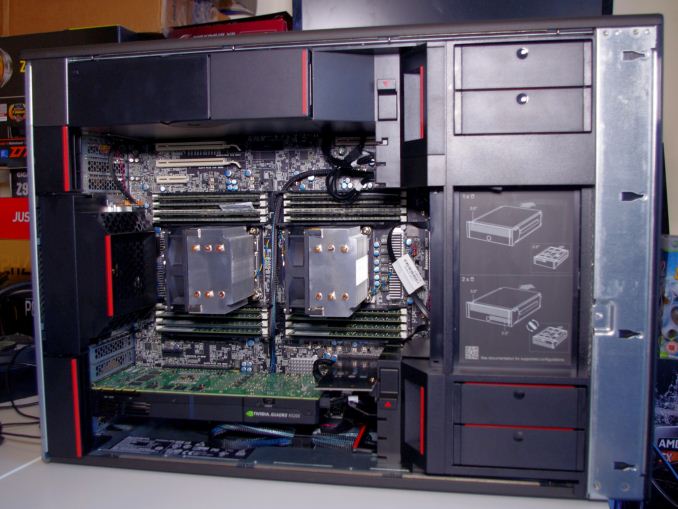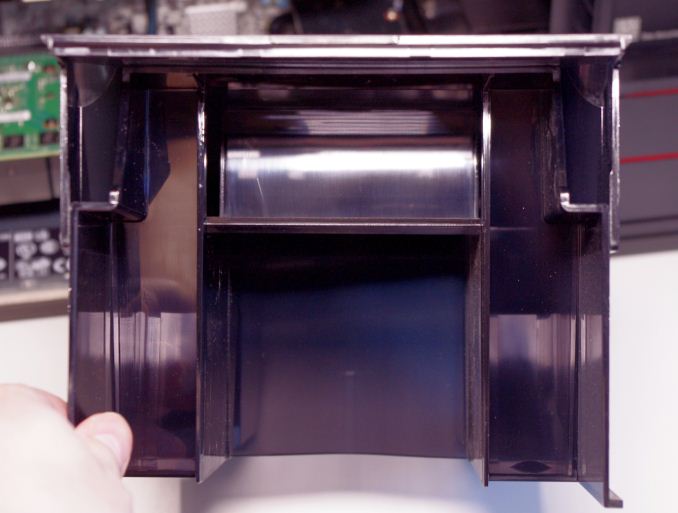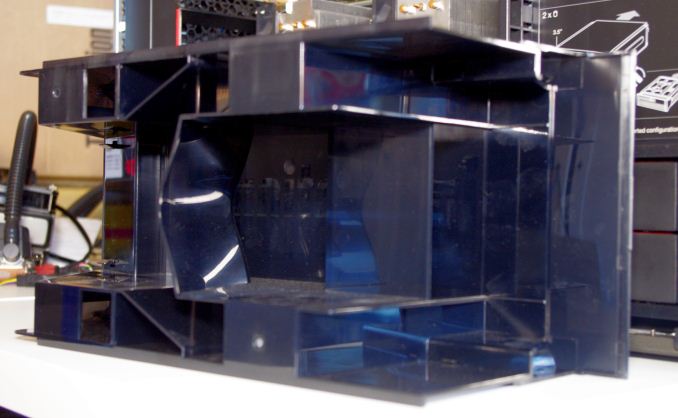The Lenovo ThinkStation P900 Workstation Review: Design 101
by Ian Cutress on May 6, 2015 7:00 AM ESTLenovo ThinkStation P900 Conclusion
As I mentioned in the introduction to the review, Lenovo is at an advantage here due to the fact that the P900 is the first high end workstation we've had in for review in quite a while. As a result it is difficult to compare the experience with the other major workstation OEMs and easy to get carried away in the positive aspects. In order to address the balance, both Dell and SuperMicro are in the process or organizing systems for us.
Despite this, Lenovo's design is pretty well done and kudos are deserved to the engineering and design teams around the P900 series. One of the key elements in workstation chassis design is the ability for system administrators to update and replace components to minimize downtime. Lenovo's design ensures that almost everything is easily replaceable, especially when it comes to drives, storage, power supplies and fans. In an attempt to minimize cabling, storage is provided either via the FLEX system or integrated into a backplane that supports both data and power. The drives for the backplane work with two drives apiece, allowing for 8 drives on the backplane and a further four PCIe devices on the FLEX connectors.
Perhaps we could point a finger and say that the PCIe devices are slightly harder to adjust, requiring a screwdriver at a minimum, but the system splits the PCIe lanes from both the processors allowing as much bandwidth as possible should multiple coprocessors be required. In order to facilitate these devices, the design also includes direct airflow through three regions - at the top and bottom the air is blown through the front, over the storage drives and through the PCIe devices then out the back. For the two CPUs in the middle, air is taken in the back and split by an air baffle into two. Each air stream then passes over an individual CPU, and the air is then directed around the ODDs and then out of the front of the case. Due to Lenovo's design, this all happens due to the arrangement of the hardware and at a relatively quiet volume. When you start enabling the power viruses the fans do kick in at a rate, but nothing unexpected for a workstation.
Performance wise, we have to grin and bear that some of our performance metrics are not particularly suited to dual processor designs. Thus despite the high end system provided with two 160W ten-core processors, sometimes for regular workloads a single processor performed noticeably faster. It even affected our SPECviewPerf numbers, despite having the better Quadro than our P300 review. That being said, I always recommend that users looking into dual processor systems know their workloads and memory requirements. If you have the software to take advantage, it always makes sense, and in our performance numbers that could take advantage of this we saw large gains over a single socket implementation especially when large amounts of DRAM are required.
One critical juncture that will be noted is the price of the unit we were sent for review. At over $16700 for a web store purchased unit, it seems at least +50% more expensive than a self-build. We saw this in our P300 review as well, to which Lenovo explained that web sales account for single digits in percentage of sales and most customers are direct b2b or to resellers that outfit with their own hardware. The prices online, Lenovo has stated, means that they are not in direct competition with their resellers and b2b customers are directed to the regional representatives for pricing.
Thus despite the cost, the P900 is designed to be Lenovo's halo workstation product in a sea of potential contenders. From a purely design point of view, I loved poking and prodding with the chassis to see how everything connected and what went where. Whatever the end user might think, the sysadmin should find upgrading and replacing components easy.













61 Comments
View All Comments
mapesdhs - Wednesday, May 6, 2015 - link
Not sure what ads you're referring to; are you using Adblock Plus? I use A.P. and the viewing is just fine. Who doesn't use Adblock or something similar these days? :)vFunct - Wednesday, May 6, 2015 - link
Most people don't use AdBlock because they're unnecessary add ons to a web browser.The less add-ons you have, the faster your web experience.
pablo906 - Wednesday, May 6, 2015 - link
If you think that browsing the web without adblock and noscript is faster I've got a bridge in Brooklyn for sale.MobiusPizza - Wednesday, May 6, 2015 - link
I agree on the annoying Seasonic ad on the left. I use Adblock Plus but I whitelisted Anandtech just to show my support. Anandtech gets ad revenue from my visit even if I don't click on it (sites get revenue based on views not clicks), adblock will deny them of the revenue.centhar - Thursday, May 7, 2015 - link
I could care less as I block every site I can. If I want to research and/or buy something, I know where to look. I hate ads and logos on everything.Flunk - Wednesday, May 6, 2015 - link
You'll find that more and more people are ignoring ads now. The company I work for keeps tabs on it and the number of non-adblock users is shrinking fast.GTVic - Wednesday, May 6, 2015 - link
Or Firefox plus NoScript. Keeps you safe from Javascript attacks and cuts out most of the advertising.bigboxes - Wednesday, May 6, 2015 - link
FF + AdBlock Plus = winShadowmaster625 - Wednesday, May 6, 2015 - link
What is the point in buying a 2P system when there is obviously a huge bottleneck between the two processors resulting in reduced performance, especially when compared to a 1P system with the same TDP?BillyONeal - Wednesday, May 6, 2015 - link
What 1P system are you aware of that had a 300+ W TDP for the processor?